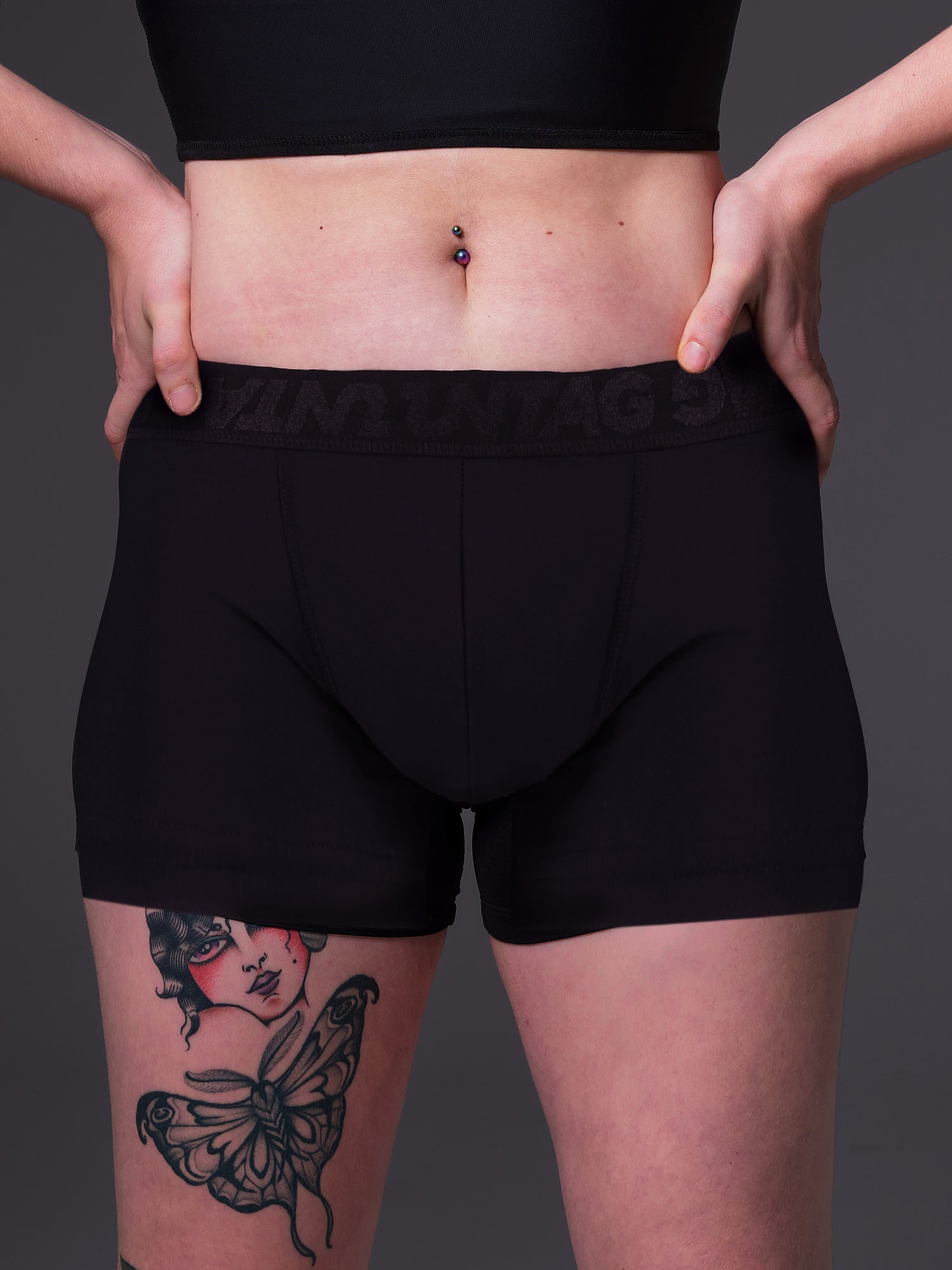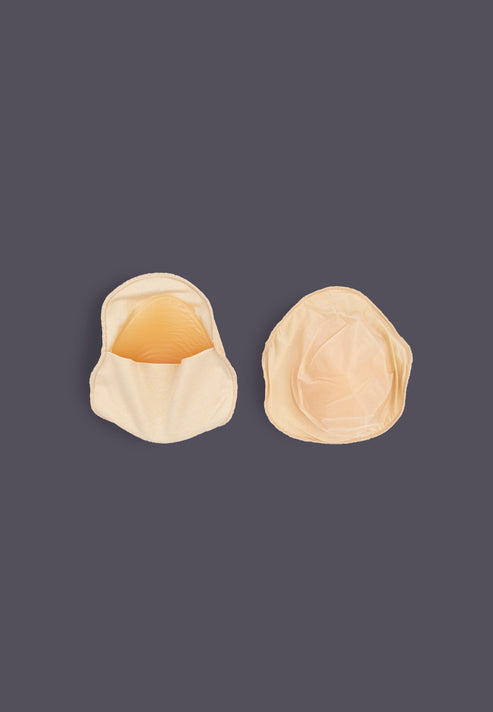Safety Information
Gender affirming garments can help you alleviate gender dysphoria by compressing or enhancing body parts that cause you negative feelings. As you can imagine, some of these gender affirming practices (like wearing binders) are not entirely without risk. At UNTAG, we hold the wellbeing of our customers close at heart, and we want to provide you with as much information as we possibly can to prevent you from accidentally hurting or injuring yourself. We’ve taken the time to compile as much safety information as we can on this page. If there are still things unclear to you, please don’t hesitate to reach out to us!

Safe Binding
Wearing a binder can be effective but not without possible health risks. Rightfully so, many people worry if wearing a binder is dangerous for their body. Always consult a doctor if you are unsure whether binding is right for you! In general, a key point of advice for wearing binders is toalwayslisten to your body. If something isn’t right, your body will send you signals that it’s time to take the binder off, or to take a break for a couple of days. If you have a tendency to dissociate from your body due to gender dysphoria and are not always in tune with how your body feels, then try and stick to the general guidelines listed below.
Collapsible content
How to put your binder on
Binders without zipper
Look at the binder: the side where the shoulders are cut deeper is the back. Roll up your binder outwards, this prevents the binder from curling up when you put it on. Pull the binder over your head and pull it down, like you would with a regular t-shirt. It’s also possible to put your binder on by stepping into it - this will take some more adjusting but is helpful if you’re unable to pull it over your head. Getting a binder on can be a little bit of a struggle - especially if you’re new to it - so be patient with yourself and take as much time as you need.
Binders with zip, hook-eye closure or Velcro.
Open the zipper, and put the binder on over your shoulders. Close the hook-and-eye closure on the inside of the top at the narrowest part of your waist on the outer eyelet. Then close the zipper, velcro or hooks. Position your breasts to get the desired result - always make sure the nipples are not pointing downwards.
Band binders
Wrap the binder around your waist. Close the hooks and eyes or the Velcro at the narrowest part of your waist. Turn the top with the closure to the correct position (front or back) and move the top up to the correct height around your chest. Model your breasts to get the flattest effect. We recommend pushing your chest diagonally to the side towards your armpit.
Binder with closure on the shoulder
Undo the closure on the shoulder. Roll the binder outwards. Pull the binder over your head. Close the hook-and-eye closure on your shoulder. Model your breasts to get the flattest effect. We recommend pushing your chest diagonally to the side towards your armpit.
If you'd like to see visual instructions on how to put your binder on, go to our Chest Binder Guide and scroll down to the section 'how do I put my binder on'
Build it up
When you start wearing binders, we recommend that you build up the time you wear them. Wear the binder for an hour first, then let your body rest again. The next day, wear it for two hours, then take it off again. Continue building this up over a couple of days; this way your body can get used to wearing a binder. Never wear a binder for more than 8 consecutive hours! If you experience any pain or discomfort while wearing the binder, or if you experience difficulty breathing, we recommend that you take off the binder as soon as possible.
Resting the body
One of the most important binder-safety tips is to never wear your binder when you're sleeping. At night, the lungs need space to move properly which is why you shouldn’t bind at night. If you find it too confronting to sleep without a binder, perhaps wear a big T-shirt or a sports top. Always remember: the safety of your body is of utmost importance. Be kind to your body! Give yourself one day a week on which you do not wear a binder or compress the chest in any way. This helps the body recover.
Binding for 8+ hours
If you have a long day ahead of you and you’re tempted to wear your binder for more than 8 hours (which we strongly advise against), it might be a good idea to take short binder breaks during your day. For example, when you’re in the bathroom, lift the binder up until it sits above the breast. Take a couple of deep breaths while stretching your torso. This gives the body a short break during the day. If you’re going to spend a long day away from home, bring a sports top or another mild compression top that you can put on once you’ve worn your binder for 8 hours. Only wear it for longer if a medical expert tells you to do so (for example after top surgery).
Breast positioning for safe blood flow
A binder works by compressing the tissue of the breasts. If the breasts are positioned incorrectly, blood flow to the nipples can be obstructed. This can lead to issues with skin elasticity which can make it harder for the body to recover after a mastectomy. The most important factor is to make sure the nipples never point downwards when binding - this can be harmful to the blood flow. Always make sure the nipples point forward, as they would without a binder.
Health risks of wearing a binder
Below is a list of some of the most common health risks that can occur with binding:
- Impediment of breath and movement.
- Skin fungi and infections.
- Other skin problems: scratching, itching, hypersensitivity, redness.
- Pain in different places: ribs, back, shoulders, abdomen.
- Muskoskeletal injuries.
- Loss of skin elasticity.
Remove your binder and consult a medical professional if you experience any of these symptoms.
Tips for secure binding
- Give your body time to recover after wearing your binder. Do not wear the binder for more than 8 hours and do not wear a binder seven days a week; schedule at least one rest-day each week.
- Do not wear two binders at the same time.
- Choose the right size.
- Do not use products that are not specifically designed for binding.
- Point the nipples forwards, never downwards.
Binding for developing bodies
Some people want to start wearing binders from the moment their breasts begin to develop. This can leave them or their loved ones worried about the safety of their developing body. The general rule is that there is no damage to a growing body or to the development of the breasts if the binder is worn in the right size. The general safety rules apply: never wear the binder for longer than 8 hours, don’t sleep in a binder, and make sure you have the correct size by checking the size chart. Especially if it's your or your childs' first binder, check the size chart or consult the customer service about the correct size.
A side note for parents, guardians, friends or other loved ones: some kids will want to figure it all out themselves and get the tightest binder that they can possibly find. Understand that your child might want the flattest result, but always remind them of the importance of safe binding! This might be a sensitive topic for them, so react with love and patience.
Exercising in a binder
The general consensus about exercising in a binder is that it is possible, but that you should keep a close eye on how you’re feeling. Some binders are made with fabric that doesn’t stretch; these types of binders are absolutely unsafe to exercise. These types of binders can prevent the ribs and lungs from expanding which could cause damage. This is why all UNTAG binders are made from a 4-way stretch material. This way you can be sure of the safety of your body, regardless of the activities you’ll be undertaking in your binder.
Only exercise in a binder if it’s specifically designed for exercising - for example our Gym Binder was developed to provide safe binding during a workout. The fabric of this binder stretches with the body so that the lungs and ribs can still expand. On top of that the back is cut lower to leave more breathing room. A general tip for exercising in a binder is to not wear one that’s extremely tight - in fact sizing up one size can also help reduce dysphoria in the gym while still being safe!
Binding with asthma, joint issues, sensory issues, or other medical issues.
For people with mobility issues, breathing issues or sensory issues, a binder with a zipper is the safest option. These types of binders can be taken off in the blink of an eye - which can be helpful for example in the event of an asthma attack. When choosing your binder, decide for yourself if you want to be able to quickly unzip and remove your binder. If you’re unsure if wearing a binder is the right decision for you, please always consult your doctor first.
Binding after top-surgery
After having had your top surgery, you are required to wear a binder for 6 weeks. This binder has to have some type of closure so you don't have to pull it over your head. We advise you to get a binder that's adjustable, like our Basic Binder Advanced. This way you can start off wearing it on the biggest size when the swelling is at it's worst, and then you can gradually wear it smaller. Do this for the first two weeks. The remaining four weeks it's also okay to wear a binder with a zipper, like our Basic Binder Zipper. Remember: your doctor has the final say in this, always listen to their advice!

Safe tucking
Tucking can be effective and affirming, but it’s not without risks. You might be wondering if tucking is dangerous for your body. Always consult a doctor first if you’re worried tucking is dangerous for you! In general, a key point of advice for tucking is to always listen to your body. If something isn’t right, your body will send you signals that it’s time to untuck or to take a break for a couple of days. We’ve listed some general rules below that you can follow.
Collapsible content
How to put your tucking undies on
Start by wrapping the head of your penis with toilet paper or cloth (this helps prevent urine leakage and infection). If you want to do a full-tuck, this is the time to push your testicles up into the inguinal canals. For the flattest appearance, lie on your back and gently shift the testes upward and into each canal. Guide them slowly without using pressure, and stop tucking if you experience pain. If you want to do a semi-tuck, simply pull them backwards. Then pull your penis back between your legs while holding your testicles in place. Once you’re satisfied with the position, pull up your tucking undies and you’re good to go.
If you'd like to see visual instructions on how to put your tucking underwear on, go to our Tucking Guide and scroll down to the section 'how to tuck'
Don’t overdo it
When you’re first starting out with tucking, we recommend that you take it step by step. Start out with tucking for an hour or so to see how you feel. Build this up, and don’t tuck for longer than 8 hours! Doing it for longer than 8 hours can cause bruising, friction or other health issues. If you feel any pain, stop tucking as soon as possible. If you feel discomfort - try rearranging your genitals and see if that feels better. Keep in mind that if you overdo it, serious health issues like skin irritation, fungal infections and even infertility can occur. Immediately consult a doctor if you’re experiencing any abnormal sensations in your genital area.
Take breaks
To give your body the rest it needs, try to take breaks as often as possible. When you’re not tucking, try to wear breathable and loose clothing. This helps the genitals recover from being restricted for long periods of time. Try to not take naps or go to sleep when you’re wearing your tucking undies, as this can lead to constriction. As a rule of thumb, take at least one day a week where you’re not tucking. Your body is a precious thing and deserves the rest!
Listen to your body
The most important thing to remember when tucking is to listen to your body. If you’re wearing a full tuck and you’re experiencing pain or discomfort, consider switching to a semi-tuck or stop tucking altogether. If you’re feeling discomfort you can also try adjusting your genitals to see if it helps.
Health risks of tucking
Below is a list of some of the most common health risks that can occur when tucking:
- Restricted blood flow to the genitals
- Skin fungi and infections.
- Other skin problems: scratching, itching, hypersensitivity, redness.
- Urinary tract infections
- Twisting of the testicles
- Nerve damage
Remove your tucking underwear and consult a medical professional if you experience or suspect any of these symptoms.
Tips for responsible tucking
- Give your body time to recover after tucking. Do not tuck for more than 8 hours in a day, and try to have at least one day a week without tucking.
- Don’t wear multiple tucking slips or thongs over each other.
- Choose the right size.
- Do not use products that are not specifically designed for tucking.
- Don’t pull on the genitals when securing your tuck.
- Take a cold shower before tucking - this will reduce the blood flow present in your penis while creating the tuck.
- Cover the head of your penis to prevent infection and spillage.
Tucking with a developing body
Some people want to start wearing tucking underwear from the moment their genitals begin to grow. This can leave them or their loved ones worried about the safety of their developing body. The general rule is that there is no damage to a growing body or to the development of the penis if the general safety rules apply: never tuck for longer than 8 hours, don’t sleep with a tuck, and make sure you have the correct size by checking the size chart. Especially if it's your or your childs' first pair of tucking undies, check the size chart or consult our customer service about the correct size.
A side note for parents, guardians, friends or other loved ones: some kids will want to figure it all out themselves and get the tightest tucking undies that they can possibly find. Understand that your child might want the flattest result, but always remind them of the importance of their safety! This might be a sensitive topic for them, so react with love and patience.
Exercising with tucking underwear
The general consensus about exercising while tucking is that it is possible, but that you should keep a close eye on how you’re feeling. Try to not tuck as tightly when you’re exercising, and consider not doing a full-tuck. The best option is to wear tucking panties without doing a full tuck. This way you’ll have a flat look, without causing damage to your genitals.

Safe packing
Although wearing a packer is generally a very safe practice, there are some things that you should keep in mind. Some key points of advice are:
- Make sure you’re not allergic to the material of the packer. If you’re using an erect prosthetic with a partner, make sure they aren’t allergic either.
- If you notice any irritation or chafing when wearing a packer for a long time, give your body a break.
- Use a water-based lube and condoms when using a prosthetic for sexual intercourse.
- Clean the prosthetic according to the brands’ instructions.
If a piece of a silicone prosthetic tears off while inserted into a partners’ private parts, be sure to contact a doctor to prevent infections.

Anxiety
When you’re using gender affirming products for the first time, a feeling of joy and euphoria can wash over you. On the flip side, they can also create a feeling of anxiety or stress. For example, when you’re wearing a binder for the first time, it’s possible you feel claustrophobic or scared that you won’t be able to take the binder off anymore (especially if you have mobility issues). If you’re anticipating a great deal of stress about getting in and out of your binder, perhaps consider getting a binder with a zipper!
The anxiety that you might feel can also stem from negative feelings around your gender identity, or confusion about what you want. Let these emotions flow through you and remember that it’s okay to experience these things. If you’re feeling overwhelmed, take your garment off, take a seat and practice some deep belly breathing. This will help you to calm down and perhaps try again when you are ready. Keep in mind: there is absolutely no rush!

Allergies
Before using any of our products, check the ‘allergies & safety’ section on the product page. In that section we have listed allergy information for that specific product. As for our fabrics, all our clothing garments are made with latex-free fabrics. Most prosthetic products contain silicone, so be sure to check whether you have a silicone allergy!
